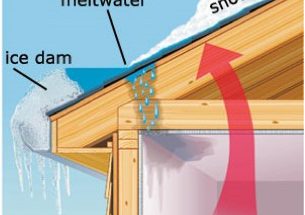THE BLOG

Hello Winter, Hello Ice Damming
Until this past weekend, homeowners of Morris County and the rest of the Northeast have enjoyed spring-like temperatures and little to no precipitation. The weather, for the most part, has been unseasonably warm, much to the chagrin of winter sports enthusiasts but a welcome respite to homeowners in New Jersey. Mild temperatures mean lower energy costs and less wear and tear on the home.
All that changed when Winter Storm Jonas roared through the Garden State, setting snowfall records and leaving drifts as high as ten feet in its wake. As residents began the task of digging out, clearing paths and driveways, above their head lurked something other than clear skies and sunshine.
Rooftops were covered with columns of fresh white powder. At first glance, this looks harmless enough; but when you mix snow covered roofs, cold temperatures, sunshine and radiant heat, the conditions are ripe for ice damming.
Ice Damming is a phenomenon that occurs when a snow load sits atop a roof and various elements go to work. What happens is this: despite temperatures being below freezing, the radiant energy of the sun along with the interior heat of the home begin melting the snow. As it melts, the resulting water follows the path of least resistance and heads for the gutters, down the slope of the roof. This is what’s supposed to happen; however, because the outside temperature is below 32°, the water entering the gutter freezes.
As this process of snow melting and refreezing continues throughout the day it doesn’t take long for the gutter to become filled with ice, creating the dam. Meanwhile the water continues to flow and eventually goes over the dam creating icicles, sometimes as long as 6 feet or more. While pretty to look at, they pose both a potential challenge and a hazard. Dripping water over entrance ways can easily turn walkways into unwanted skating rinks. Good if your Dorothy Hamill, but certainly not something you want your guests to encounter.
Meanwhile, back on the roof, the melting snow has created a sort of river rushing towards the gutter line, which is now fully dammed up. Some of the water cascades over the dam, as mentioned, and the remaining run-off pools behind the dam. As the sun sets and temperatures drop, this freezes. As it freezes, it expands. Here is where the real trouble begins with regards to your home’s interior.
The Stage is Set

Overnight the expanding ice begins to lift the roof shingle. As morning dawns the radiant energy of the sun and the ambient temperature of the house begin the thaw process. However, if your roof is missing one vital component, then the roofing nails used to secure the asphalt shingles to the deck now become a conduit for the melting ice and now you’ve got a very unwelcome guest in your house. In addition to the water mess, you now have a potential for hundreds or even thousands of dollars of damage.
The one component that can protect your home’s interior is called Ice & Water Shield. Just about every major roofing manufacturer makes their own brand; GAF has Weather Watch®, Moisture Guard® is Tamko’s brand, and Atlas produces WeatherMaster® 200.
When properly installed, this underlayment can protect your home’s interior from ever experiencing leaks due to ice damming. To be clear, this product doesn’t prevent ice damming, it prevents melting ice from ever getting into your structure when ice damming occurs. It’s included in a professionally installed roof; and by the way, it is code in New Jersey.
About webmaster
